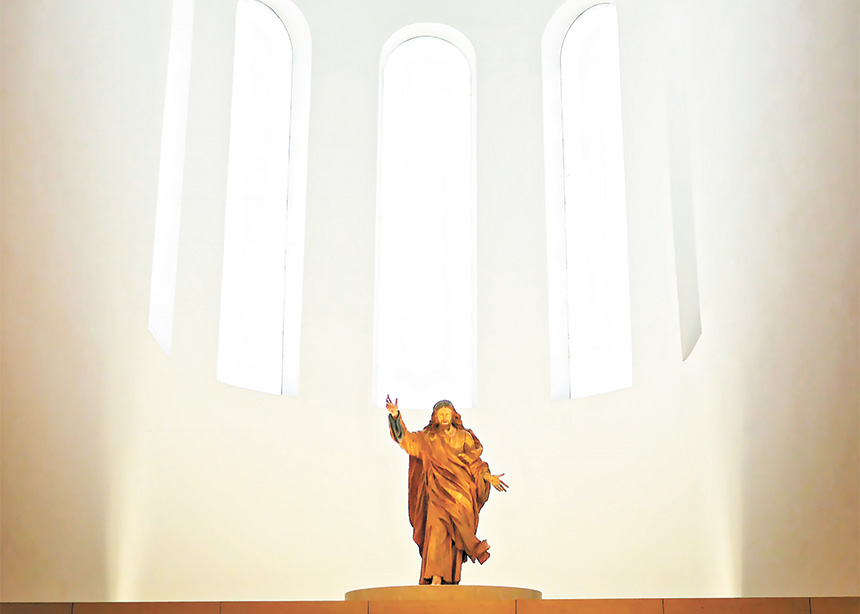Easter is a time to speak a message of lavish grace, of love personified and of unending hope. This is a day to leave guilt, shame and fear tangled up with the linen strips inside that empty tomb. Our Lord has risen! Hallelujah!
Today we ask the questions:
- Who is this Jesus who loved humanity enough to go into the grave?
- Who is this God who is so good and so powerful that death could not hold him?
- Who are we now in light of this, as people of the Resurrection?
Before we explore these questions, we must recognize how important the resurrection of Jesus is to our faith; indeed, our whole belief hinges on this idea. Death was the great enemy, the great fear, the great separation. In raising Jesus from the dead, God said to humanity, “This Jesus is my son, my Beloved, the One who has defeated death. Listen to him. Put your hope in him.”
The empty tomb of Jesus—the idea that his previously dead body is now up and around in an eternal physical body—is both preposterous and essential to Christian faith. It is the core of all preaching in Acts. If Christ was not raised, we are miserable fools, Paul tells us in I Corinthians.
Reading the story in John 20:1-18, I cried with Mary Magdalene. Here was a woman so grief-stricken, so desperately sad, that she mistakes her beloved Jesus for a gardener. I was struck by the physicality of the story, by Mary’s anguish, by the disciples’ breakneck run to the tomb, by the angels plunked down in the tomb, by the aliveness of Jesus’ voice as he said to her, “Mary.”
The Resurrection is not a story of ghosts, ethereal hopes or far-off heavenly places. This is a story that is alive on the ground; a story of real possibilities, of a God who, in the greatest act of love, came to earth, lived among us, died—as we all will—and then came back from the grave to be with us. And this gospel, this good news, changes everything. That is the story we need to hear.
First, it’s important we know that Jesus was embodied. He was as real and as physically alive as you and I are right now. Jesus is not, and was not, a concept, an idea, a level of goodness that we can attain by just reaching a little further, by just being a better version of our current selves.
During Holy Week, I watched the daily reflections by Kate Bowler on her Instagram account. Kate is a professor and historian of the church, and author of the book Everything Happens for a Reason and Other Lies I’ve Loved.
She said, “What is really striking me this week is that what we have in Holy Week is a story about the past, the present and the future. We have a story about how our world was so broken that we needed God to save us. And then we have a story about the present, where we have a Jesus who walks beside us looking around saying, ‘No, I get it, and I see it too.’ And then we have a story about the future, which is that God does things for us that we can’t do.
“It drives me insane that we’ve got all these self-help brands saying, ‘You can do it!’ Sometimes we can’t! And we don’t just find the goodness inside of ourselves and piece it together. We’re not always good. It’s so freeing to say that sometimes we need to be saved.”
Coming toward us
These things shouldn’t make us despair about our own human condition. The grace of God doesn’t come to us once we’ve attained some level of perfection or some level of self-loathing.
The grace of God comes to us exactly as we are and exactly where we are—weeping outside a tomb. Sweating from running to see if the body was gone from where it had been laid. In locked rooms, afraid to answer the door for fear of what might be on the other side. God’s grace comes to us in our own reality, not just in some far-off, future reality. Grace comes because Jesus came back to us, real and alive on this earth.
Jesus Christ doesn’t invite us to his heavenly state; he comes to us in our earthly state. God could have demanded that we make the first move. God could have put the onus on us to attempt to bridge the separation, to reach out and grasp for the hand of God. Rather, God reached out to us. God saw that there was division and enmity between us and God, between us and one another, and God made the first move.
In Romans 5:6-11, the Apostle Paul writes, “When we were utterly helpless, Christ came at just the right time and died for us sinners. . . . But God showed his great love for us by sending Christ to die for us while we were still sinners. And since we have been made right in God’s sight by the blood of Christ, he will certainly save us from God’s condemnation. For since our friendship with God was restored by the death of his Son while we were still his enemies, we will certainly be saved through the life of his Son. So now we can rejoice in our wonderful new relationship with God because our Lord Jesus Christ has made us friends of God.”
There’s a lot of damaging theology that makes God into a jilted lover, a distant judge, a God who is more concerned about us joining him in heaven than about the years we spend here on earth. But that is not the message we get from Romans, nor is it what we see in the interaction between Jesus and Mary in John’s resurrection story.
After her encounter with the risen Jesus, Mary Magdalene went to the disciples with the news: “I have seen the Lord!” While she was weeping, when she was feeling far off from everyone and everything, when she thought this was all over, Jesus had called Mary by name.

The Resurrection invites us also to see the Lord, to see him here among us, to hear him call our names. Jesus comes to us in flesh and blood, in bread and wine, in birth and death. And that is precisely what makes him a perfect Saviour, precisely what makes his demonstration of love the greatest one we’ll ever know.
So, what does this mean for us? What does it mean to be people of the Resurrection everyday as we walk, work and weep in this world?
It means that we are beloved by God. As I help shape my children’s faith lives, I want them to know that they are loved by God. My daughter, in her growing spiritual perceptiveness, has asked why Jesus didn’t stay dead, like her great- grandmother. We’ve told her that it’s because God’s love is so big, that it was bigger than something as sad and scary as death, so Jesus came back to life.
If Scripture tells that Jesus’ death and Resurrection was the ultimate act of love and solidarity with us and for us, and that God calls us friends, then we must seek to live out that reality, now.
Further, it means that, if Jesus’s Resurrection was real, audacious and physical, surely nothing in us that is dead or lost is beyond the reach of God’s resurrection power. No dark secret. No terrifying pandemic. No unjust system. No wounded heart.
The late Rachel Held Evans, in her book Searching for Sunday, writes, “Death and resurrection. It’s the impossibility around which every other impossibility of the Christian faith orbits. Baptism declares that God is in the business of bringing dead things back to life, so if you want in on God’s business, you better prepare to follow God to all the rock-bottom, scorched-earth, dead-on-arrival corners of this world—including those of your own heart—because that’s where God works, that’s where God gardens. Baptism reminds us there’s no ladder to holiness to climb, no self-improvement plan to follow. It’s just death and resurrection, over and over again, day after day, as God reaches down into our deepest graves and, with the same power that raised Jesus from the dead, wrests us from our pride, our apathy, our fear, our prejudice, our anger, our hurt and our despair.
“Most days I’m not sure which is harder for me to believe: that God re-animated the brain functions of a man three days dead, or that God can bring back to life all the beautiful things we have killed. Both seem pretty unlikely to me.”
So, people of the resurrected Jesus, on the days when these things seem pretty unlikely, on the days when we wonder if God’s love extends to us, on the days when following Jesus seems too hard, it is my prayer that we will see God’s resurrection power and love, and that we can cry out, like Mary, “I have seen the Lord!”
Emily Summach is pastor of Langham (Sask.) Mennonite Fellowship.
For discussion
1. Easter is a time for rejoicing. What Easter traditions express that sense of joy? What songs, foods or decorations do we associate with Easter? Are they direct expressions of Jesus’ Resurrection or are they connected more generally with the rebirth that comes in springtime? Is Easter a more important holiday than Christmas?
2. Emily Summach writes that the Resurrection of Jesus is vitally important to the Christian faith, saying “[O]ur whole belief hinges on this idea.” Do you agree? What does the Resurrection say to us about death and about hope? Summach says that, after the Resurrection, Jesus was “up and around in an eternal physical body.” What do you think she means by an “eternal physical body”?
3. Summach says that the grace of God comes to us exactly where we are, not after we have attained some level of perfection. How tempting is it for Christians to assume that grace comes only to those who deserve it? How do we access God’s grace?
4. Jesus is here among us now, says Summach. In light of that fact, what does it mean to be “people of the Resurrection?” What kind of people are we called to be? How does the hope of the Resurrection colour our outlook?
—By Barb Draper








Leave a Reply
You must be logged in to post a comment.